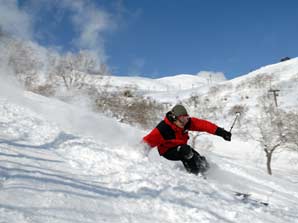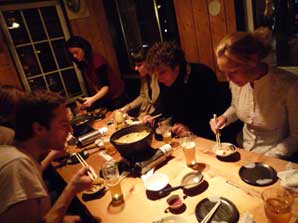Web Japan > Trends in Japan > Food & Travel > Niseko: Hokkaido’s Powder Snow Paradise
Niseko: Hokkaido’s Powder Snow Paradise
The Best Snow in the World—and Abundant Hot Springs

Skiers can enjoy some of the best powder snow in the world.(C)Skier in Niseko Grand Hirafu Resort
Enlarge photoLocated in western Hokkaido, Niseko is one of the world's finest ski resorts, internationally renowned among snow-fans for the superlative quality and quantity of its crisp, fluffy, three-meter deep powder snow. Some 700,000 skiers and snowboarders visit every year.
Awe-Inspiring Scenery, Perfect SnowNiseko means "sheer cliff" in the language of Hokkaido’s indigenous Ainu people. As the name suggests, Niseko’s main attraction has always been its awe-inspiring mountain scenery. To the east, the perfect cone of Mt. Yotei soars high into the heavens; to the north is Niseko Annupuri, the highest peak in a volcanic chain. The Shiribetsu River flows between these mighty peaks, one of the most picturesque unspoiled rivers in Japan. The river presents a breath-taking spectacle in the warmer months, swelled by snowmelt and reflecting the surrounding majestic mountain scenery like a mirror.

Outdoor hot springs are the perfect place for skiers to unwind after a day on the slopes.(C)Niseko Yugokoro-tei Onsen
Enlarge photo“There are four major ski resorts spread across the foothills of Niseko Annupuri,” says Hamaguchi Kendo of the Niseko Resort Tourist Association. “This gives the region a rich range of diversity and variety for the skier. The Niseko Annupuri International Ski Resort is famous for its long gradual slopes set between growths of trees, offering a course suitable for everyone from beginners to expert-level skiers. At the Niseko Grand Hirafu Ski Resort, meanwhile, visitors can enjoy stunning close-up views of Mt. Yotei as they ski.”
Over the past decade, the outstanding quality of the snow at Niseko has attracted widespread attention from skiers and snowboarders overseas, bringing large numbers of visitors from Australia and New Zealand to Niseko's slopes during the southern hemisphere summer. Asian visitors have been flocking to Niseko in recent years for their first taste of skiing. Niseko is well on its way to becoming a truly international winter sports resort.
Fifteen Unique Hot Spring ResortsBesides resort hotels and condominiums, Niseko is also home to numerous onsen (hot spring) inns. The prospect of reviving ski-weary limbs with a soak in a natural hot spring is a major attraction for many visitors. In and around the small towns of Niseko, Kucchan, and Rankoshi in the foothills of Niseko Annupuri are no fewer than 15 hot springs, each offering different restorative and therapeutic qualities. Two inns draw their waters from the Niseko Goshiki (five-colored) Onsen-kyo. The name comes from the bluish-green water, rich in sulfur and magnesium, which varies slightly in color from day to day. There are also outdoor bathing facilities, where visitors can take the waters in the heart of majestic unspoiled scenery. The two inns at Niimi Onsen-kyo retain an atmosphere of seclusion, far from the bustle of city life. The 100% pure hot spring waters are extremely popular with locals and visiting skiers alike.

There are a variety of shops and restaurants for visitors to enjoy after a day of skiing.(C)Abucha - local Japanese restaurant
Enlarge photoThe black soil of the Niseko region, rich in volcanic minerals, is said to be ideal for growing tasty potatoes, and many different varieties are produced locally. One local dish that makes use of these ingredients is the piping hot imo dango jiru (potato dumpling stew). The potatoes are boiled, mashed, and kneaded into long strands before being chopped into bite-sized dumplings and simmered in a soy-based stock along with radishes and other vegetables. The tasty soup is on offer at the Michi no Eki (roadside station) on the national highway and other local outlets in Niseko town.
In winter, deep snow covers the plant life of Niseko. The mountain scenery undergoes a dramatic transformation in spring and summer once the warmer weather finally arrives in May.(February 2011)
- Otaru, Hokkaido (October 2008)

